Difference between revisions of "Quercus incana"
(→Ecology) |
HaleighJoM (talk | contribs) (→Ecology) |
||
| Line 52: | Line 52: | ||
Populations of ''Quercus incana'' have been known to persist through repeated annual burning.<ref>Platt, W.J., R. Carter, G. Nelson, W. Baker, S. Hermann, J. Kane, L. Anderson, M. Smith, K. Robertson. 2021. Unpublished species list of Wade Tract old-growth longleaf pine savanna, Thomasville, Georgia.</ref> | Populations of ''Quercus incana'' have been known to persist through repeated annual burning.<ref>Platt, W.J., R. Carter, G. Nelson, W. Baker, S. Hermann, J. Kane, L. Anderson, M. Smith, K. Robertson. 2021. Unpublished species list of Wade Tract old-growth longleaf pine savanna, Thomasville, Georgia.</ref> | ||
| − | ===Pollination and | + | <!--===Pollination===--> |
| + | ===Herbivory and toxicology===<!--Common herbivores, granivory, insect hosting, poisonous chemicals, allelopathy, etc--> | ||
''Q. incana'' has been observed to host treehoppers such as ''Ophiderma pubescens'' (family Membracidae).<ref>Discoverlife.org [https://www.discoverlife.org/20/q?search=Bidens+albaDiscoverlife.org|Discoverlife.org]</ref> | ''Q. incana'' has been observed to host treehoppers such as ''Ophiderma pubescens'' (family Membracidae).<ref>Discoverlife.org [https://www.discoverlife.org/20/q?search=Bidens+albaDiscoverlife.org|Discoverlife.org]</ref> | ||
| − | |||
<!--===Diseases and parasites===--> | <!--===Diseases and parasites===--> | ||
Latest revision as of 14:45, 15 July 2022
| Quercus incana | |
|---|---|

| |
| Photo taken by Kevin Robertson | |
| Scientific classification | |
| Kingdom: | Plantae |
| Division: | Tracheophyta- Vascular plants |
| Class: | Magnoliopsida - Dicotyledons |
| Order: | Fagales |
| Family: | Fagaceae |
| Genus: | Quercus |
| Species: | Q. incana |
| Binomial name | |
| Quercus incana W. Bartram | |

| |
| Natural range of Quercus incana from USDA NRCS Plants Database. | |
Common name: Bluejack oak
Contents
Taxonomic notes
Synonyms: Quercus cinerea Michaux; Q. humilis Wlater
Description
A description of Quercus incana is provided in The Flora of North America.
Distribution
Ecology
Habitat
Q. incana has been found in turkey oak-longleaf pine stands, sand dunes, sand pine scrub, longleaf pine-wiregrass ridges, slashpine flatwoods, dry pine barrens, upland woods, and evergreen oak scrub.[1] It is also found in disturbed areas including along roadsides, clear cut longleaf pine forests, and burned pinewoods.[1]
Associated species: Q. myrtifolia, Quercus marilandica, Opuntia humifusa, Stillingia sylvatica, Tephrosia virginiana, and Quercus-Ilex.[1][2][3][4]
Quercus incana is restricted to native groundcover with a statistical affinity in upland pinelands of South Georgia.[5]
Q. incana has shown regrowth in reestablished longleaf pine woodlands that were disturbed by agriculture in South Carolina, making it a post-agricultural woodland indicator species.[6] It also increased its density in response to disturbance by roller chopping in west Florida sandhills.[7]
This species became absent in response to military training in west Georgia longleaf pine forests.[8] Q. incana reduced its frequency and density in response to roller chopping in northwest Florida sandhills.[9] It also became absent and decreased its occurrence in response to agriculture in north Florida pinelands.[5] It has shown resistance to regrowth in reestablished habitats that were disturbed by these activities.
It does not respond to soil disturbance by clearcutting and chopping in north Florida flatwoods forests.[10]
Quercus incana is frequent and abundant in the Panhandle Xeric Sandhills, North Florida Subxeric Sandhills, and Clayhill Longleaf Woodlands community types as described in Carr et al. (2010).[11]
Phenology
Q. incana has been observed flowering in March and April.[12]
Seed dispersal
This species is thought to be dispersed by gravity.[13]
Fire ecology
Populations of Quercus incana have been known to persist through repeated annual burning.[14]
Herbivory and toxicology
Q. incana has been observed to host treehoppers such as Ophiderma pubescens (family Membracidae).[15]
Conservation, cultivation, and restoration
Cultural use
Photo Gallery
References and notes
- ↑ 1.0 1.1 1.2 Florida State University Herbarium Database. URL: http://herbarium.bio.fsu.edu. Last accessed: June 2021. Collectors: A. H. Curtiss, Robert Doren, Angus Gholson, Robert K. Godfrey, Robert L. Lazor, and Dwayne Wise. States and counties: Florida: Calhoun, Duval, Franklin, Gilchrist, Highlands, Levy.
- ↑ Louisiana State University, Shirley C. Tucker Herbarium accessed using Southeastern Regional Network of Expertise and Collections (SERNEC) data portal. URL: http://sernecportal.org/portal/collections/index.php Last accessed: June 2021. Collectors: Charles M. Allen. States and Counties: Louisiana: Saint Helena
- ↑ Lundell Herbarium at the University of Texas at Austin accessed using Southeastern Regional Network of Expertise and Collections (SERNEC) data portal. URL: http://sernecportal.org/portal/collections/index.php Last accessed: June 2021. Collectors: Jimmy R. Massey. States and Counties: Mississippi: Newton.
- ↑ Mississippi Museum of Natural Science Herbarium accessed using Southeastern Regional Network of Expertise and Collections (SERNEC) data portal. URL: http://sernecportal.org/portal/collections/index.php Last accessed: June 2021. Collectors: Lucas C. Majure. States and Counties: Texas: Robertson.
- ↑ 5.0 5.1 Ostertag, T.E., and K.M. Robertson. 2007. A comparison of native versus old-field vegetation in upland pinelands managed with frequent fire, South Georgia, USA. Pages 109–120 in R.E. Masters and K.E.M. Galley (eds.). Proceedings of the 23rd Tall Timbers Fire Ecology Conference: Fire in Grassland and Shrubland Ecosystems.
- ↑ Brudvig, L.A., J.L. Orrock, E.I. Damschen, C.D. Collins, P.G. Hahn, W.B. Mattingly, J.W. Veldman, and J.L. Walker. (2014). Land-Use History and Contemporary Management Inform an Ecological Reference Model for Longleaf Pine Woodland Understory Plant Communities. PLoS ONE 9(1): e86604.
- ↑ Burns, R.M. and R.D. McReynolds. (1972). Scheduling and Intensity of Site Preparation for Pine in West Florida Sandhills. Journal of Forestry 70(12):737-740.
- ↑ Dale, V.H., S.C. Beyeler, and B. Jackson. (2002). Understory vegetation indicators of anthropogenic disturbance in longleaf pine forests at Fort Benning, Georgia, USA. Ecological Indicators 1(3):155-170.
- ↑ Hebb, E.A. (1971). Site Preparation Decreases Game Food Plants in Florida Sandhills. The Journal of Wildlife Management 35(1):155-162.
- ↑ Moore, W.H., B.F. Swindel, and W.S. Terry. (1982). Vegetative Response to Clearcutting and Chopping in a North Florida Flatwoods Forest. Journal of Range Management 35(2):214-218.
- ↑ Carr, S.C., K.M. Robertson, and R.K. Peet. 2010. A vegetation classification of fire-dependent pinelands of Florida. Castanea 75:153-189.
- ↑ Nelson, G. PanFlora: Plant data for the eastern United States with emphasis on the Southeastern Coastal Plains, Florida, and the Florida Panhandle. www.gilnelson.com/PanFlora/ Accessed: 13 DEC 2016
- ↑ Kirkman, L. Katherine. Unpublished database of seed dispersal mode of plants found in Coastal Plain longleaf pine-grasslands of the Jones Ecological Research Center, Georgia.
- ↑ Platt, W.J., R. Carter, G. Nelson, W. Baker, S. Hermann, J. Kane, L. Anderson, M. Smith, K. Robertson. 2021. Unpublished species list of Wade Tract old-growth longleaf pine savanna, Thomasville, Georgia.
- ↑ Discoverlife.org [1]
